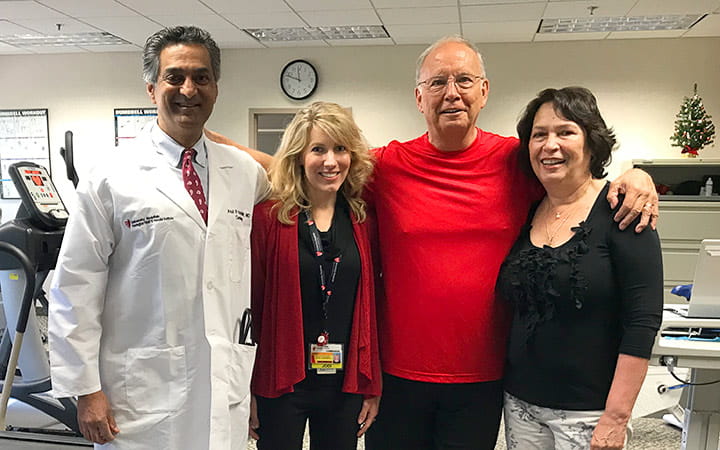Cardiac Rehab Helps to Change One Man’s Life and Enables Him to Help Others
July 14, 2019

When Westlake resident Lee Rankin walked into University Hospitals St. John Medical Center Cardiac and Pulmonary Rehabilitation in 2016, he didn’t realize the impact the caregivers there would have on his health and his life. What started out as a stress test before cardiac surgery has turned into a passion for the now 69-year-old, and he’s giving back as much help as he receives.
Lee, who refers to himself as “Frankenstein” due to the many medical procedures he has endured, first came to UH St. John Medical Center Cardiac Rehabilitation in 2016 at the request of his cardiologist Atul Hulyalkar, MD. He was about to undergo a procedure to replace a valve in his heart and a stress test was a prerequisite.
Cardiac rehabilitation is a supervised program that typically begins in the hospital after a patient has experienced a cardiac event, then continues on an outpatient basis.
Exercise Physiologist Jodi Weiler, MS, explains UH St. John Medical Center Cardiac Rehab’s three-phased team approach as follows: “In Phase 1, we meet our patients in the hospital and explain how cardiac rehab works, and what they can expect during their sessions. Phase 2 consists of outpatient monitored exercise at our facility, along with education on nutrition, stress management and living a healthy lifestyle. Patients often wear a heart monitor during this phase. And, Phase 3 is what we call our maintenance program. Patients can come into our facility anytime during business hours and exercise independently.”
Jodi, who has been with UH St. John Medical Center for 19 years, has helped thousands of patients, but considers Lee special. “Lee is a fighter. He’s had to face a lot of obstacles with his health, but through his efforts, he has not only vastly improved his own health, he has become a role model for other patients in our program. He engages with other patients, shares his successes and encourages them to keep moving.”
When Lee began cardiac rehab, he weighed 238 pounds. He’s now down to 217 with a 15 percent increase in muscle mass. His blood pressure went from 148/85 to 110/70 and his cholesterol is less than 160. He has also maxed out the weight on the facility’s leg press – 490 pounds.
“Cardiac rehab provides excellent continuity of care,” said Dr. Hulyalkar. They take over after the inpatient care ends. But, with some of our patients, the advice we give them unfortunately goes in one ear and out the other. However, Lee took my advice to go to cardiac rehab to heart – and the results speak for themselves.”
Patients get out of cardiac rehab what they put into it. As an undergraduate, Lee was an offensive guard on the University of Minnesota’s football team and he attributes much of his motivation to the extreme workouts during his college years.
However, Lee says that cardiac rehab is not just physical, but mental and emotional as well. “I had to dig deep to keep myself motivated,” said Lee. “But, UH St. John Cardiac Rehab is an extremely special place. I’ve experienced many business cultures throughout my life, and I’ve never seen anything like this. We’re like a family. Miracles happen here.”


